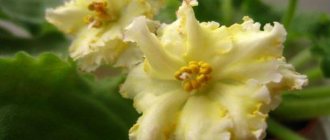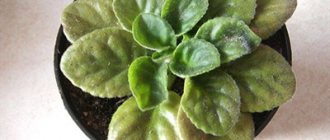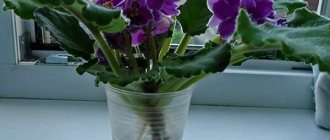Violet is one of the most beloved indoor plants, which has many varieties. Since interest in this flower is only growing, breeders are constantly developing new species and varieties of violets. There are both miniature species and giant plants, violets that develop in the form of rosettes or those that have long hanging shoots - the ampelous group. It is ampelous violets that are becoming increasingly popular, because with their help you can transform any corner of the house by planting various varieties of this species in hanging flowerpots. Next, let’s take a closer look at the characteristics of this plant and find out the features of growing ampelous violets.
The history of the flower
It’s quite difficult to even name the homeland of violets.
It grows in Japan, North America, Australia and New Zealand. But it came to Europe from the shores of East Africa.
According to one of the stories about violets, the commandant of German East Africa, Adalbert von Saint-Paul, was walking in the Usambara Mountains with his bride.
She noticed an inconspicuous purple flower between the stones, which had an unsurpassed aroma.
By a lucky coincidence, the commandant’s father was the president of the German Dendrological Society, Ulrich Saint-Paul, to whom the seeds of a flower were sent, “which glows with pale blue fire,” as Adalbert wrote about him in his diaries.
The discoverer's father gave them to the botanist Hermann Wenland, who confirmed that it was a new flower and named it "Saintpaulia" in honor of Adalbert von Saint-Paul.
Violet conquered Europe already at the first exhibition, which was held in Belgium, and at the beginning of the twentieth century, the conquest of the United States began, where a specialized society was opened that was engaged in breeding new varieties of the flower.
Note! Violet growing wild was familiar back in ancient Greece, where myths and legends were composed about it. But it gained real popularity only in the 19th century.
To date, botanists have managed to develop several thousand varieties of color, despite the fact that initially about 20 species were known.
The most unusual violets
It should be noted that this flower can be quite unusual, for which it is highly valued by flower growers, because you never know what the outcome will be. The most interesting varieties are the following:
- “Chimera” is a variety resulting from the mutation of two plant species. The color of the petals varies from blue to crimson, but there is always a light dividing line in the middle.
Violet “Chimera”
- An exotic variety called “Crimson Cloud Country” has a dark crimson color with an intricate pattern.
Violet “Land of Crimson Clouds”
- “Gray Ocean” is a flower that has the ability to change color to suit the mood, turning from white to lilac. With each flowering it becomes darker, and the Gray Ocean variety turns into the Black Pearl.
Violet “Grey Ocean”
There are a lot of varieties of violets; every year breeders try to present something new and unique at exhibitions, so it is not possible to mention them all. But each of the varieties is unique and beautiful in its own way.
The article examined the main varieties of indoor violets. This is a beautiful flower that can decorate any space.
Exhibition varieties are more beautiful, but have a lot of nuances in breeding, which will turn a hobby into exhausting work.
However, regardless of the choice, the interior of the room, decorated with live violets, will be transformed beyond recognition.
How to care for it to bloom?
With proper care, Saintpaulia can bloom without a break for a whole year, but in order for it not to become depleted, a two-month break is needed.
The violet will show itself in all its glory if you provide it with:
- sufficient, but not excessive lighting;
- proper watering;
- regular feeding;
- protection from drafts;
- timely removal of withered flower stalks and daughter rosettes that appear in the leaf axils;
- transplant 2 times a year;
- a cramped pot, since in a spacious one it will not bloom at all or will produce few weak peduncles.
Do not forget that Saintpaulia is a short-lived plant and is already considered old at the age of three.
A few words about ampelous violets and their features
This is an ideal flower option for hanging baskets, pots and containers. Each plant has several growing points, so they differ in the number of shoots or drooping stems. In addition, during the growing season a large number of lateral branches are formed, which is why violets are also called “trailer” violets.
Among the trailers there are bush and canopy types, so you can form both a bush and a canopy cascade from them. Believe me, when cascading violets bloom, you can’t take your eyes off them, it’s just an avalanche of flowers. And if you grow violets of several shades at once, then this is truly a fabulous sight.
Today, gardeners know about 500 different varieties of trailer violets, which allows you to purchase several of them at once and successfully decorate with them any space in the garden, at home, on a terrace, in a gazebo or in the entrance area of a house.
Classification of varieties of indoor violets
There are many varieties of violets, varying in size, flower shape, number and color of petals. Moreover, the same variety can belong to several groups. Now we will try to understand the classification of indoor violets.
According to socket size
Micromini. They have a rosette diameter of up to 8 cm. Against their background, ordinary Saintpaulias with a diameter of 20-40 cm look like giants. They are grown only in compact pots with wick watering. Otherwise, the risk of them drying out is too high - if left without moisture, they dry out and die quite quickly.
Mini. The diameter of the rosette of such a violet does not exceed 12-15 cm. Just like microminis, they are grown, most often, with wick irrigation. They tolerate propagation well and therefore take root faster than larger varieties. During flowering, they form many attractive, bright and original inflorescences.
Half mini. They have a rosette diameter of up to 20 cm. Most of these varieties were bred with the participation of the domestic botanist Igor Milekhin. It is important to know that excess light is harmful for semi-mini violets! In a short time, all the foliage may turn yellow, and the rosette becomes flat in shape.
Standard - rosette 20-40 cm in diameter.
By flower size
Based on flower size, violets are divided into the following groups:
- small-flowered - up to 2 cm;
- medium-flowered - from 2 to 4 cm;
- large-flowered - from 4 to 6 cm;
- especially large-flowered - more than 6 cm.
Types by flower shape
Depending on the size and location of the petals, there are 5 types of indoor violets:
- Pansies;
- Star;
- Bell;
- Bowl;
- Wasp.
By degree of terry
Also, varieties of violets can be divided according to the degree of terryness or the number of petals. On this basis, all violets are divided into the following groups:
- Simple (5 petals).
- Comb type is a type of semi-double Saintpaulia, in which, in addition to five petals, there are 1 - 3 additional underdeveloped ones.
- Semi-double is when the peduncle has more than 5 but less than 10 petals, most often 7-8. In this case, the stamens are clearly visible.
- Terry is a type of violet in which the number of petals exceeds 10. There are so many of them that they cover the stamens.
- “Carnations” are Saintpaulias, the flowers of which are similar to double ones, but larger, with more petals on the peduncle. In appearance, such Saintpaulias really resemble carnations, hence the name.
Along the edge of the petal
The petals of Saintpaulia are wavy, notched and fringed.
By color
Indoor violets, based on the color of the petals, are divided into plain and painted in two or more colors.
Ampelous
We can also distinguish a group of currently very fashionable hanging varieties of indoor violets, which have a long stem (up to 50 cm) with several growth points. These Saintpaulias are distinguished by their lush flowering. Their stems are quite flexible, so you can try to create a variety of compositions from them. The characteristic color of the leaves is variegated. The flowers are miniature but attractive. Let us introduce you to some varieties of ampelous violets:
Ramblin' Dots. Breeder S. Sorano.
Ramblin Dots is a beautiful variety of indoor violet. The rosette consists of light green leaves with golden-white streaks. Its double star flowers are light lavender in color and decorated with a mesmerizing light purple fantasy pattern.
Falling Snow. Breeder P. Tracey.
Folin snow is a violet with light green, slightly pointed leaves. It has numerous small snow-white wasp flowers.
Variegated
Violets from the variegated group have elegant, brightly colored foliage with many different shades and contrasting spots throughout the green field. They can have yellow or white edges, a lavender or pink border at the same time. These violets have large double flowers with petals of various colors, often with a prominent border along the edge.
Pauline Viardot
This violet has a compact variegated rosette, very elegant due to the light border along the edge of the leaves. Its large, single or semi-double flowers have wine-colored petals. The edges of the petals are decorated with a thin white ruffle. Pauline Viardot's flowers grow vertically.
Ampelous violets: varieties with names
Ampelous violet Robs Vanilla trail: photo of the variety
Breeders from many countries are working on developing new plants. To date, the number of ampel varieties has already exceeded five hundred. Below we give examples of several varieties classified by gardeners as among the most decorative.
- The ampelous violet variety “Lituanika” is the result of the work of Lithuanian breeders. This plant is distinguished by its highly dense inflorescences and slightly elongated leaf blades. The flowers have a soft pink color with a barely noticeable peach tint. In combination with dark green leaves, a rosette of blooming violet looks very elegant. Another reason for the popularity of this violet is its abundant and long-lasting flowering. The plant received its name in memory of two American pilots of Lithuanian origin who attempted to fly from the capital of Lithuania to New York in 1933. Lituanik's plane successfully crossed the Atlantic Ocean, but never reached its destination, crashing under unclear circumstances.
- The next variety of ampelous violet is “Robs Vanilla Trail”. This violet is one of the semi-miniature trailers, the size of the leaf plate of which is 2.4-3.8 cm. The name of the variety corresponds to the color of the flowers, which have a slightly creamy, milky tint. The flowers are double, and the foliage is very prominent with a jagged edge. This variety was bred by American breeder Ralph Robinson. By the way, all the varieties he received have the prefix Robˊs.
- The Milky Way Trail variety is also a representative of semi-miniature plants. The flowers are semi-double, very small in size, white in color, which harmoniously combines with the green leaves. Flowering is abundant and long lasting.
- The “Dancing Trail” ampelous violet is distinguished by rather long peduncles, which, over time, form a real cascade. The flowers are double, red-crimson in color. The leaves are rich green with a slight sheen. The shape of the leaf plates is slightly elongated with a pointed edge.
- The “Trail Along” variety is one of the miniature violets, with a leaf blade up to 2.5 cm. Many elongated drooping peduncles are decorated with soft pink flowers. Double inflorescences with deeply separated petals give the plant a special decorative appearance. The flowering of violets of this variety seems endless.
- The ampelous violet "Rondita" is a semi-miniature trailer. The shape of the flowers resembles the opened buds of very small roses. Flowers that have just bloomed have a soft pink color, while those that have already faded have a barely noticeable pink tint. The leaf blades are round, with a pointed edge, and look like hearts. Violet blooms very profusely, but not for long, since the variety is industrial. That is, after a certain time, flowering ends and the plant will not bloom again. Attempts to propagate this variety are useless.
Ampelous varieties of Williams violets
Williams violet (V. x williamsii)
Synonyms. Pansies.
Distribution area. Everywhere in culture.
Botanical characteristics. A perennial of hybrid origin, similar to Wittrock's violet (U. x wittrockiana). It differs from the latter in having stronger branching, a greater abundance of flowering, but smaller flowers (diameter, depending on the variety, from 2 to 5 cm).
The colors of the flower, like those of the Wittrock violet, are very diverse, with spots and shading of other colors. The flowering of this variety of violets begins at the end of April and continues throughout the warm season.
Growing conditions. Prefers nutritious, moist and loose soils, sunny or semi-shaded places. Very cold-resistant, neutral to day length.
Usage. An excellent plant for pots and hanging baskets in which it can form flowering cascades, these varieties of violets can also be widely used as bedding plants.
Varieties. Series F1 Angel (F1 Angel) - plant height 12-15 cm, flower diameter 3-4 cm. Consists of 16 varieties with different flower colors, including 'F1 Angel Tiger Eye' - with orange-yellow flowers with bright brown veins. Used for decorating containers.
Cottage series - plant height 10-12 cm, flower diameter 2 cm. Consists of 4 varieties of violets with yellow-blue, purple-white, red-yellow, violet-cream coloring of flowers. Used to decorate containers.
Series F1 Sparkler (F1 Sparkler) - plant height 7-10 cm, flower diameter 4-5 cm. Consists of 4 varieties with bright, two- and three-color flower colors. An ideal group for hanging planters and baskets.
Trailer landing
Ampelous violets: photo
Trailer violets, like other types of violets, prefer very light soil, which should contain leavening agents such as perlite and peat. Over time, given the high moisture capacity and looseness of the soil, its volume decreases noticeably. In this case, it is enough to simply pour the soil mixture into the pot. Additionally, complexes of mineral substances can be added to the top-up soil mixture.
For planting hanging violets, you should choose low containers, because a significant part of the root system of the trailers is located on the surface, and a large pot volume is not required for hanging shoots of the plant.
Trailers are replanted no more than twice a year. As a rule, transplanting violets is due to the need to divide them.
If the planting conditions are met, violets will grow quite actively, and in order to preserve the decorative appearance of the plant, you can resort to the following methods.
Timely re-rooting of rosettes will help to avoid exposing hanging shoots. Usually, the need for it arises 8 - 9 months from the beginning of active violet growth. At the same time, each plant has its own characteristics, depending on which, this period may be longer or shorter.
Ampelous violets, which have one stem growing upward, are formed in the form of a bush. When the shoot reaches a certain length, it is laid on the surface of the soil in the form of a semicircle. The sockets on it will, over time, take root and begin to grow. As a result, a lush bush is formed.
Also, many gardeners practice growing several plants of different varieties with different flower colors in one container. Considering the small size of the trailers, the plants in no way interfere with each other's development. Well, it is, of course, unnecessary to talk about the high decorativeness of such flowerpots.
Caring for Saintpaulia
The window sill of the western window, it is very hot in summer, burns may remain on the leaves, so on sunny days, from 16:00, a curtain made of white fabric is lowered on the window. But it’s already autumn, there is less and less sun, so shading is not needed - additional lighting is needed.
How to properly transplant ampelous violets
Many gardeners find it difficult to answer the question: how often should plants be replanted? I will say right away that this is determined by the age and size of the plant. For small bush species, replanting can occur twice a year without damage.
For specimens that look like a real clearing, the replanting process in a container can be carried out every two or even three years. Firstly, it is quite difficult to plant such a plant; secondly, you can use the method of adding fresh nutrient soil directly into the pot, thus, partial renewal of the surface soil will occur without loss. In addition, the accumulation of minerals on the soil surface will be partially removed.
For different varieties of violets, pots of different shapes should be selected. So, for flowers in the form of a clearing, low and wide containers are suitable, and for bush species, narrower and deeper ones. But, it must be said that most violets do not like containers that are too deep, since the roots are on the surface of the soil. But the drainage layer will not interfere at all in any case and with any varietal preferences.
Trailer or ampel violets produce hanging lashes, so to increase the length, you need to plant the plant in a hanging pot or place it on a stand. Some types of trailers are formed by magnificent cascades strewn with flowers and look very impressive, not inferior in beauty to hanging petunias and many other crops of a similar structure.
Among the parasitic insects that like to attack the ampelous violet are mites, aphids, and whiteflies. The fight against them is carried out with the help of chemicals that are widely represented on today's market. Spraying is carried out several times a year, especially if your violets grow in the garden.
How to propagate ampelous violet
The most common method is leaf propagation. This is done quite simply:
- Several leaves are carefully cut off from the mother plant.
- To be effective, cuttings are treated with a root formation stimulator, for example, Kornevin.
- After this, the leaves can be placed in sphagnum moss, peat tablet or soil.
- The top of the planting should be covered with a plastic cover or glass, such as a jar.
After a month, roots should appear on the cuttings. This means that it can be planted as an independent plant in a separate pot.
Some gardeners propagate violets by rooting side shoots, but this method is less effective, and the overall appearance of the main plant is disrupted. However, if you really want it, then this method is completely justified.
Of course, the seed planting method is not excluded, but it will require patience and skill from you. You can grow the variety you like yourself, with planting material, loose soil and a strong desire to win!
Violet seeds have a fairly high germination rate, so if you want to experiment, be sure to plant them. The seeds are too small, so they are laid out on damp soil and covered with film. After about 20 days you will see how they have sprouted. Next, the seedlings are grown as ordinary seedlings.
Ampelous or trailing violets are amazing plants, striking with their tenderness, beauty and magnificent shape. They are able to evoke the deepest feelings, especially when the entire cascade is strewn with their flowers. Try to plant flowers on your site, and you will forever be fascinated by their unique, exquisite appearance, especially when it comes to double varieties.
Lighting
Violets are big lovers of sunlight, so the most preferred directions of light for them will be the western and eastern sides. Despite.
Because they adore the sun, they should be protected from direct rays, as radiation can significantly damage plants, cause burns and leaf disease.
Therefore, make sure that the containers with flowers are somewhat removed from the direct rays of the light.
This is one of the few plants that can delight you with flowering almost all year round. The main condition for this is illumination; violets need a long daylight hours, at least 10-12 hours.
When the day outside becomes significantly shorter, you should give them an additional light source, such as a fluorescent lamp.
Depending on the different shapes, the lighting also varies; some varieties require side lighting, others simply need lighting from above.
Temperature
The main thing in growing ampelous violets is to avoid drafts and sudden changes in air temperature. However, there is one trick or, so to speak, whim: the fact is that these cute beauties love a slight discrepancy in day and night temperature readings. In other words, the conditions of their maintenance should be close to the natural environment.
The optimal temperature regime will be air heated to 20-21 degrees; for young animals the heat should be raised by two to three degrees.
Air humidity
Saintpaulias love humid air (about 50-60%). But it is not advisable to spray them - only during extreme heat, not the bushes themselves, but the air around them with a very fine spray. And to moisten, it is worth placing pots with plants on a tray with wet pebbles or damp moss so that moisture does not get into the pot. If there are central heating radiators nearby, hang them with damp towels - this becomes necessary on very cold days in winter, when the heating is at full blast, and even hair and clothes begin to become electrified from dryness.
Priming.
Since trailer violets are characterized by rapid growth and frequent flowering, the soil must be selected accordingly. In general, its composition does not differ from the compositions for standard violets (at least for me), except for the ratio. I use one of the types of peat (Baltic Peat, Klasmann TS1, Kekkilä Professional) and foam chips in a ratio of 60:40. Polystyrene foam can be replaced with perlite.
I use the same type of pots for trailers, but different sizes.
When choosing the appropriate size, be guided by your “planned” shape of the future plant.
- for mini trailers I use a pot diameter of 12cm, height 6cm, volume 0.3l
- for small standards, pot diameter 16cm, height 7.5cm, volume 0.7l
- for standards, pot diameter 20cm, height 8.5cm, volume 1.3l
These pots are very convenient; if you remove the tray (it is secured with latches), you will get an excellent bottom of the pot with many holes. This way you can easily stretch the wick, and it’s convenient for regular watering.
For the aesthetics of hanging varieties, such a pot can easily be placed in a beautiful decorative high pot.
23-River Tarusa (Yan Zubo) 23-River Tarusa (Yan Zubo)
Watering
The amount of water used during irrigation depends on the size of the container in which the violets grow, as well as on the composition of the substrate. Flowers love moisture, but too frequent watering can cause rotting of the root system, and this in most cases leads to the death of the plant.
In small pots, the soil always dries out faster than in large containers; given this fact, it is worth checking the condition of the soil more often and adding moisture if it dries out. If you suspect something is wrong and you have an idea about the initial rotting of the roots, you should immediately remove the plants from the container and inspect it.
If upon inspection you can see brown roots, then you were right and the plant is in danger. In this case, the delay in death is similar, emergency measures should be taken, which boil down to removing rotten roots and even the lower parts of the shoots. After the operation, the plant is placed for rehabilitation in a special substrate, in the form of moss - sphagnum or light soil.
Violets are also very sensitive to dry soil; their leaves begin to dry out and flowers fall off. The color of the leaves becomes pale.
Fertilizers.
When using the traditional method of watering violets, trailers are fertilized frequently, with almost every watering, alternating types of fertilizers depending on the stage of plant development.
When using wick irrigation, fertilizers are added each time when filling containers with water, in a concentration that is half that specified in the instructions for it.
I think it is a mistaken opinion that trailer violets need an increased dose of fertilizer. After all, in essence, what difference does it make how many plants are planted in a pot? Each stepson will “drink” the solution that you poured. And there is no way he will be able to “pull out” some more elements and not give it to the “neighbor.” And if we increase the concentration of fertilizer, we can easily get an “overdose” and burn the roots.
It is better to use the minimum dosage but constantly, also alternating the compositions depending on the need.
Such fertilizers as Fertika Lux, Fertika flower, Peters Professional and various microbiological fertilizers (Kaliyvit, Phosphatovit, Azotovit) have proven themselves well.
With each watering I also add Fitosporin paste concentrate. It interacts well with fertilizers and protects the plant from various putrefactive processes.
NE-City of SevastopolNE-City of Sevastopol
Trimming
Caring for Saintpaulia at home includes regular preventive inspections of the above-ground parts. Dried or mechanically damaged leaves are immediately cut off with a sharp, disinfected instrument.
Some gardeners remove “extra” plates to make the plant look symmetrical. In other cases, Saintpaulia does not need pruning.
Formation of a flower bush
Many varieties of trailer violets require the formation of a bush outline, otherwise they can grow into a shaggy and awkward plant. There are several ways to create a beautiful specimen, and each gardener chooses the one that suits him:
- You can get the right trailer violet bush from a single child with about 10 leaves. The growth point of such a plant is pinched, due to this the axillary shoots begin to grow. After they are sufficiently decorated, the lower leaves of the plant are removed, and at the same time, damaged or non-standard leaf plates are cleaned. For a beautiful volume of the trailer violet bush, only a few of all the axillary children are left (ideally 5);
Children of the trailer violet.
- when planting several plant children in a circle in one pot, they eventually form a clearing, which requires formation by removing excess leaves and directing shoots to empty spaces;
- It is ideal to form ampelous varieties of trailer violets in a flowerpot on a high leg or in a hanging pot. In this case, part of the plant’s stems are directed downwards, and the remaining stems growing next to them are pinched to create volume in the flowerpot itself;
- Another way of forming ampelous varieties of trailer violets involves laying out the stems of the plant on the substrate - gradually, with the help of new children, an even carpet will be obtained.
ATTENTION! For all methods of forming the outline of a violet trailer, it is necessary to thin out the leaves, control the uniform elongation of the main stems of the plant, and fill the bare areas with newly formed shoots. When these rules are followed, trailer violets turn out to be even, symmetrical plants with evenly filled space with leaf blades and buds.
Rest period
Uzambara violet is an evergreen perennial. It never sheds its leaves, so it does not have a pronounced dormant period. In Saintpaulia there are only short breaks between flowering phases. At such moments, you can provide the crop with shade and slightly reduce watering: thanks to this, more buds will subsequently form.
Main diseases and pests
Root nematodes (Root nematodes) are one of the most dangerous pests for Saintpaulias. o round microscopic worms that penetrate living tissue, sucking out cell sap and releasing harmful substances. In affected Saintpaulias, swellings form on the roots - galls that look like beads.
At the initial stage, the disease does not affect the appearance of the plant in any way, but later the stem becomes deformed, many stepsons appear on it, the leaves become limp, the affected areas of the stem rot and the plant dies.
It is impossible to save the violet, but to preserve the variety, you need to cut off a still healthy leaf, root it and grow the Saintpaulia again. A preventive measure is the selection of initial soil components. Do not take soil from greenhouses, greenhouses, or flower farms.
The nematode does not take root in soil containing manure, and if possible, add well-rotted manure to your soil at the rate of 1 liter per 1 bucket.
Thrips are microscopic light-colored insects, no more than 1.5 mm long, visible on dark flowers, mainly affecting buds, and contributing to the appearance of powdery mildew. When infected with thrips, flowers bloom underdeveloped, with open anthers, the flowers are pollinated and wither earlier than usual.
Thrips can be recognized by the pollen scattered on the petals. At the first signs of damage in all plants, it is necessary to remove flowers and buds, thereby depriving thrips of food. After this, spray the plants and the top layer of soil with an insecticide (actellik, actara, spintor).
Treatments are carried out 2-3 times with an interval of 7-10 days.
Strawberry (cyclamen) mite is not visible to the naked eye, but its presence is indicated by the following signs. In the center of the rosette, wrinkled, more pubescent leaves of a gray or brown color appear, as if the plant was sprinkled with ash; in this case, the stem is shortened, the leaves and petioles become brittle.
The buds fall off; if the flowers bloom, they are ugly or underdeveloped. Infected plants are treated with actellik or actara, as indicated in the instructions. If you don’t waste time, the plant can be saved.
Fungal diseases are caused by fungal spores that enter the plant with dust through contaminated planting equipment.
Powdery mildew is a white coating on the leaves, which, when washed off, reveals a leaf surface covered with ulcers. Severe damage leads to the death of leaves and death of the entire plant. For treatment, one treatment with a fungicide (Topaz) is sufficient, at the rate of 1 ampoule per 10 liters of water.
Late blight is a fungal disease that leads to the sudden death of a plant. The disease begins with slight wilting, as if the plant has dried out, but after watering it becomes limp even more, the base of the stem rots, trapping the leaves.
Another common fungal disease is gray rot. Excessive humidity contributes to the spread of the disease. If a disease is detected, all affected leaves and peduncles should be removed, the plant should be treated with a fungicide and the air humidity should be reduced.
Rotting of the stem and roots is the first sign, withering of the lower leaves, as happens with a dried out plant.
There are many reasons for this - watering with cold water and excessive waterlogging, too heavy soil, a sharp change in temperature, too large a pot, excessive depth of the plant, stagnation of water in the center of the outlet.
You can save the plant by cutting off the top and re-rooting it. Usually some varieties are more susceptible to this, some less.
Rotting of leaf petioles - the root and stem remain healthy, sometimes the leaf blade can be affected, and brown spots appear. When treating, remove all diseased leaves and treat the plants with a fungicide.
Content Rules
Lighting
The ideal location for trailer violets is with either east or west exposure. These plants need a lot of light, but the violet must be protected from direct sunlight.
Trailers can bloom all year round. The main condition for this is proper care in the matter of providing lighting. For constant flowering, violets require 10-12 hours of daylight. Therefore, in the cold season, plants need to be provided with an additional source of light. A good option would be to use a fluorescent lamp. However, it is worth remembering that trailers with different growth shapes need to be illuminated differently. Hanging plants growing at a height need to be illuminated from the sides, but those growing in bushes should be illuminated from above.
Air temperature
The ampelous violet blooms most readily if the conditions of maintenance provide a difference in night and day temperatures. There is no need for sharp fluctuations; a couple of degrees will be enough, as close as possible to natural conditions. Cold drafts generally have a detrimental effect on all violets, including trailers. The ideal ambient temperature for trailer violets is 20-22 degrees, but young plants will be more comfortable with a slightly warmer temperature of 22-24.
Soil requirements
It is necessary to grow trailer violets in light, breathable soil. The basis of such soil should be peat, perlite with vermiculite. The soil may not be included in the substrate.
Watering mode
The amount of watering depends largely on the size of the pot and the condition of the soil. This is important to prevent waterlogging of the soil, which in turn can lead to rotting of the roots and death of the flower. In a larger pot, there is correspondingly more soil and the longer it takes to dry out, so this must be taken into account before the next watering. Drying can also be delayed by heavy, packed soil that does not have good drainage and has problems with breathability. If you suspect overmoistening, you need to release the violet rhizome from the pot and evaluate its condition. Brown, easily torn roots are direct evidence of this. To save the plant, it needs to be provided with special emergency care. First of all, it should include removing the affected parts of the rhizome. Next, the plant, cleared of rot, needs to be transplanted into light soil or sphagnum moss.
Trailer violets are also very sensitive to dry soil.
Fertilizing
Fertilizers should not be applied immediately after transplantation. But after two months, caring for the ampelous violet can be supplemented with fertilizing. The flower will appreciate a good balanced fertilizer.
Transfer
The frequency of replanting depends on the age and size of the plant. Small violets will have to be replanted twice a year. But there are also specimens, especially those grown in the form of a clearing, which are very difficult to transplant without loss. They can be left in the same container for up to two years, but you should not forget to carefully update the top layer of soil from time to time. This is done in order to remove accumulated excess mineral fertilizer residues.
For replanting, you need to choose a pot based on where and what shape the violets will grow. To form a violet in the shape of a clearing, a low, wide pot is suitable.
The beautiful effect of hanging vines is easier to achieve by planting the trailer violet in a hanging pot or a pot on a leg.
Diseases and pests
Mites, aphids, and whiteflies can annoy the trailer violet.
Picking and landing in the ground
Picking of seedlings is carried out after the formation of 2 leaves on the seedlings. For transplantation, use containers with a diameter of 10 cm or large boxes, maintaining a distance of 6 cm between sprouts. An important condition for the correct further development of the plant is maintaining the level of its recess, which will prevent the seedlings from collapsing. When 3 pairs of leaves are formed, pinching is carried out to promote tillering of the ampelous viola.
Young plants are transplanted to a permanent location in May or June, when the soil has warmed up sufficiently and the threat of frost has passed. A sunny location with soil that has good breathability is suitable. The procedure takes place in several stages:
- dig holes 6-7 cm deep for each bush at a distance of 15 cm from each other;
- drainage in the form of small pebbles is placed at the bottom;
- transfer the pansy bushes with a lump of earth into the prepared holes;
- sprinkle the seedlings with soil, providing abundant watering.
Important! The soil does not need to be compacted, which will eliminate the lack of oxygen access to the root system; water is poured under the root.
Reproduction
Using the leaf propagation method, the cutting develops roots in a month to two. The leaf can be rooted in a peat humus tablet, or soil with a baking powder base. You can also use sphagnum moss. It is also a good idea to cover the seedling with polyethylene for the first few days after planting.
You can also resort to rooting a side shoot. It is advisable to use this method if a shoot on a plant is unnecessary and interferes with the formation of a beautiful cascade or bush form. After all, such forms and growth are achieved precisely due to the preservation of lateral shoots on the plant.
Useful videos
Watch a video about what a trailer violet is: A detailed video on how to form trailer violets: From this video you will learn how to plant a trailer violet: Video review of trailer violets:
Sources
- https://ss-p.ru/remont/ampelnie-sorta-fialok-senpolii-osobennosti-i-virashchivanie.html
- https://TaoBerry.ru/sadovye/ampelnaya-fialka-foto.html
- https://ss-p.ru/dizajn-i-planirovka/voshititel-nye-ampel-nye-fialki-sorta-i-foto.html
- https://ogorodnash.ru/ampelnye-fialki/
- https://cvetoshki.ru/mnogoletniki/vidy-i-sorta-fialok-botanicheskaya-harakteristika.html
- https://lux-pole.ru/domashnie/ampelnaya-fialka-foto.html
- https://cvetokmir.ru/ampelnye-fialki.html
- https://komnatnie.com/fialki/uhod-fialki/raznoe-f/trejlery.html
- https://zen.yandex.ru/media/id/5d4dc50e35c8d800ac8483bc/fialki-treilery-ot-a-do-ia-poshagovyi-masterklass-602680ebb498705a810b02cc
- https://zabor22.ru/komnatnye/ampelnye-fialki-sorta.html











